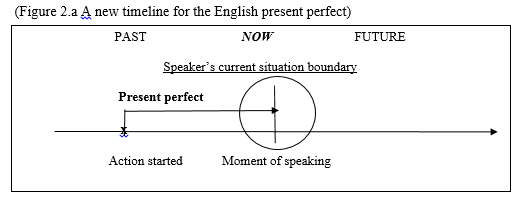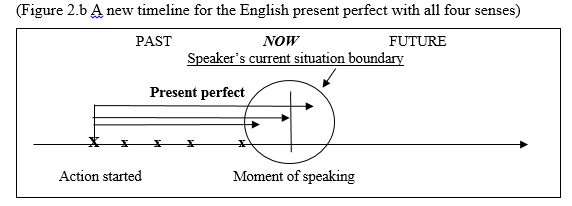|
| |
A new way of teaching the English present perfectJiwon LeeIn this paper, I introduce a new broad  definition of the present perfect with a new timeline that is both simpler and more effective for teaching it to ESL students. In the first section, I introduce the origin of current definitions. In the second section, I discuss three reasons for the difficulty in understanding the present perfect. In the third section, I illustrate a new way of teaching the present perfect with a new broad definition and a new timeline. definition of the present perfect with a new timeline that is both simpler and more effective for teaching it to ESL students. In the first section, I introduce the origin of current definitions. In the second section, I discuss three reasons for the difficulty in understanding the present perfect. In the third section, I illustrate a new way of teaching the present perfect with a new broad definition and a new timeline. Origin of the current definitions of the English present perfect In the early 1970s, two interpretations of the English present perfect emerged (McCawley,1971 and Bennett and Partee, 1972). Only McCawley’s interpretation has influenced the current definitions of the English present perfect. He illustrates the English present perfect with four senses: universal, existential, stative and hot news, depending on the frequency, possibility of continuousness, and effectiveness of the current situation of a past action. His original illustrations are below. 1) McCawley’s four senses (1976: pp104) (a) universal: to indicate that a state of affairs prevailed throughout some interval stretching from the past into the present: (31) I’ve known Max since 1960. (b) existential: to indicate the existence of past events: (32) I have read Principia Mathematica five times. (c) stative: to indicate that the direct effect of a past event still continues (33) I can’t come to your party tonight – I’ve caught the flu. (d) hot news: to report hot news: (34) Malcolm X has just been assassinated. His illustration emphasizes subtly different senses of the present perfect; thus, the vital broad concept –an event connected between past and present—is absent. The problems of understanding the current definitions and descriptions of the English present perfect Even though most teacher reference books include all four senses of the English present perfect (cf, Swan, 2003, pp445-460), most current ESL textbooks do not explain either of the four senses or the core meaning of the present perfect, in which the past action is somewhat related to the speaker’s current situation whether the past action influences the speaker’s situation directly or indirectly or whether the results of the action are noticeable or not. ESL textbooks mostly include three senses of the present perfect: some ESL textbooks exclude hot news/recent past sense, and some others combine the resultative sense with hot new/recent past. The example below shows that the definition is for the hot news sense and the example is for the resultative sense. 2) how news/recent past: The present perfect describes a completed action or event with a connection to the present e.g., The children have read the rules. They are ready to play the game now. (Grammar Explorer 2, p 36) Another problem is that most ESL teachers check the teacher’s editions of textbooks rather than teacher’s reference books for classes. Therefore, many ESL teachers are not exposed to the explicit definitions of the present perfect. Also, the TESOL literature does not discuss the English present perfect much; I only found one article out of 40 that coped with the correct English present perfect meanings (cf, Aitken: 1993). Even worse, Parrott Martin, an international ESL teacher trainer and CEO of an international TESOL organization in Britain, suggests using other forms for the present perfect and argues that teaching the English present perfect is unnecessary for English learners due to the complexity of the concept (cf, Parrott: 2001). The third problem is that the essential meaning of the present perfect -- involvement of the speaker’s intention -- is not illustrated in the textbooks. The English present perfect structure (have + past participle) consists of tense and aspect, which carries the speaker’s intention. In other words, a speaker who uses the present perfect form indicates that the past event is somewhat related to the speaker’s current situation. That is why the form itself contains present form have and the past participle form. Yes- It might be complicated to explain all the details about aspect, tense, and the speaker’s intention. However, knowing the existence of the relation between present and past in the present perfect structure will help ESL students to understand the meaning of the present perfect. When I found out this fact, all my questions about the present perfect were solved. I understood why the simple past or present perfect form can describe the same situation. The example is below. 3) I have visited Europe (present perfect) vs. I visited Europe (simple past). Both sentences are grammatically correct and semantically appropriate depending on what the speaker wants to say. The first sentence means the speaker visited Europe, so he or she has something to mention at the moment of speaking. Meanwhile, the second sentence informs that the speaker visited Europe without carrying any further information. Thus, the speaker chooses to use one of these structures. However, the most common suggestion for the present perfect is to refer to the time frame to distinguish the present perfect and the simple past (e.g., for or since is used for the present perfect). This suggestion is not helpful for understanding the present perfect. Therefore, I have developed a new way of explaining the present perfect with a new timeline to provide the core meaning of the present perfect including all four senses without any confusion by temporal adverbs. A new explanation of the present perfect with a new timeline My new explanation of the present perfect is that it describes a past event that is somewhat connected to the speaker’s current situation, including the moment of speaking. Also, I added a circle and an x to mark the traditional present perfect timeline in order to address the ambiguity of the descriptions by the temporal adverbs. (cf, Figure 1 and Figure 2).   The circle indicates the time boundary of the moment of speaking, Now, the boundaries of which are flexible. For instance, the time boundary could be, for example, a day or an indefinite amount of time either way from the moment of speaking, depending on the speaker. Also, the present perfect arrow exhibits the past action marked by x continues to Now. I have introduced timeline 2.a for the broad concept and proposed timeline 2.b for the four senses. First, I must explain the role of the circle and the present perfect arrow. Once the students understand the flexibility of the time boundary and the meaning of the arrow, they can comprehend the concept of the present perfect.  In timeline 2.b, in any cases when a head of an arrow is inside the circle, it indicates a situation where the present perfect is used. First, the longest present perfect line with consecutive x’s mark the universal meaning of the present perfect: the action started in the past and it continues until now. Second, the longest present perfect line with a few x’s exhibits the experiential meaning of the present perfect: the action happened in the past at least once and it may happen again in the future. Third, the second longest line with one x shows the resultative meaning of the present perfect: the action started in the past and completed right before the speaking moment. Fourth, the short present perfect line with one x indicates recent past meaning of the present perfect: the action started and completed in the past, but it affects the current situation. Thus, my purpose for introducing this broad definition and the timelines is to provide the concept of the present perfect while explaining all four of these meanings of the present perfect. Conclusion I realize that the actual teaching strategies of the present perfect descriptions in current ESL textbooks is necessary for ESL learners. Hence, I hope this article opens a door for TESOL scholars to re-consider how to teach the present perfect and help ESL grammar teachers searching for the best and easiest way of explaining complex grammar points. Bibliography Aitken, R (1993), Questions on Grammar (2) Zielsprache Englishch Vol 23, No 1. pp 25 -27, Tubingen, Stauffenburg. Bennett, M. and Partee, B. (1972). Toward the logic of tense and aspect in English. Bloomington: Indiana University Linguistics Club. Daphne Mackey; Paul Carme; Amy Cooper; Samuela Eckstut-Didier (2014), Grammar Explorer 2, Cengage Learning. McCawley, J. D. (1971). Tense and Time Reference in English. Studies in Linguistic Semantics. No.8, pp97-114. Holt, Rinehart and Winston, Inc. Parrott Martin (2001), Grammar Fallacies of Our Age I, II, and III Modern English teacher, Vol. 10, No.2, pp. 20- Hants: Macmillan ELT. ________ Jiwon Lee teaches English grammar and tutors TESOL subjects at Northeastern Illinois University Home Page | |
| ITBE Link - Fall 2016 |